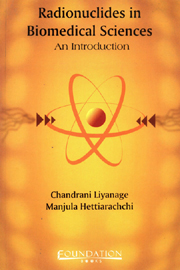Book contents
- Frontmatter
- Contents
- Forewords
- Introduction
- 1 Atomic and Nuclear Structure
- 2 Radiation Detectors
- 3 Units of Radiation Measurements
- 4 Iodine–125
- 5 Radioimmunoassay
- 6 Quality Control in RIA
- 7 Radiolabelled Compounds
- 8 Radiation Safety
- 9 Radiation Protection
- 10 Background Radiation
- 11 Storage
- 12 Contamination
- 13 Radioactive Waste
- References
8 - Radiation Safety
Published online by Cambridge University Press: 26 October 2011
- Frontmatter
- Contents
- Forewords
- Introduction
- 1 Atomic and Nuclear Structure
- 2 Radiation Detectors
- 3 Units of Radiation Measurements
- 4 Iodine–125
- 5 Radioimmunoassay
- 6 Quality Control in RIA
- 7 Radiolabelled Compounds
- 8 Radiation Safety
- 9 Radiation Protection
- 10 Background Radiation
- 11 Storage
- 12 Contamination
- 13 Radioactive Waste
- References
Summary
RADIATION SAFETY RULES
The radiation protection rules of a country are usually specified in the Radiation Control Act of that country. In Sri Lanka, the Atomic Energy Authority (AEA) is the state authority responsible for radiation safety and protection, under the Atomic Energy Authority Act no. 19 of 1969.
Listed below are some typical requirements/regulations of a radiation control act:
a. It is mandatory to obtain a license from AEA to use radiation or radioisotopes.
b. Uses of radiation must be suitably modified once licensed by AEA.
c. Staff working in areas of significant radiation levels must have their exposure monitored.
d. Radiation Protection Division of AEA may check on facilities and work practices.
e. All radiation sources and areas must be clearly marked with the radiation warning sign.
f. All radiation workers must be properly trained and supervised.
g. The Radiation Safety Authority must register radiation laboratories and equipment.
All nuclear medicine personnel are required to prevent the entry of radioactive material into the body in the first place. The laboratory facilities should be carefully designed to keep the radiation doses As Low As Reasonably Achievable (ALARA) and it is a cardinal rule for a nuclear medicine laboratory. Developing good laboratory work habits is an equally important matter; one needs to comply with the International Commission on Radiation Protection's (ICRP) recommendation that all doses be kept as low as practicable.
POTENTIAL EXPOSURE, SAFETY ASSESSMENT
Accidental exposure may occur due to equipment failure, human error or a combination of both. Although such events can be anticipated by a careful safety analysis, their details and the time of occurrence cannot be predicted. These exposures are called potential exposures.
- Type
- Chapter
- Information
- Radionuclides in Biomedical SciencesAn Introduction, pp. 89 - 97Publisher: Foundation BooksPrint publication year: 2008

